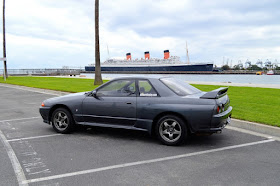 |
| 1991 Nissan Fiagaro |
In this case a 1991 Nissan Fiagro that is legal in Canada, because it is over 15 years old, was purchased by a man in Massachusetts.
Costello spotted this Figaro on eBay a year ago, having been brought in from Canada. He was searching for antique cars on eBay at the time, but the Figaro popped up through a fluke in the listing system.“So before I bought the car I brought them [Massachusets DOT] a photo of the car and an 8x11 copy of the title. So they did a dry run and told me that I could, in fact, buy the car 'cause it was a kit. And I said 'No it's not a kit. It's a car.' We went back and forth, and they said 'Well, you can register that car 'cause it's titled.' So I went and bought the car.”
Read more: http://www.autoweek.com/article/20130809/carnews01/130809852#ixzz2jtQpTpp4
Follow us: @AutoweekUSA on Twitter | AutoweekUSA on Facebook
The Massachusets DOT is not the FEDERAL DOT. It is a local agency that handles vehicle registration, not vehicle importation.
The NHTSA - DOT are the ones that handle vehicle import. In this case, since the car was in Canada, it was likely just driven though the border. Vehicle import is not a huge issue from Canada to the US, but Canadian cars still need to meet US standards to be legally imported. Driving though the border, is not a legal importation. To legally import this car, the importer would have had to fill out a:
HS7 - NHTSA import form
and a 3520-1 - EPA import form
It would have likely been stopped at the border, because currently the laws do not allow this car. Show or Display - this car is on the list of vehicles not approved for import. More than 500 of them made, and it is not of any historical or technological significance. It may have retro styling, but styling alone isn't enough to qualify for Show or Display. However, this car is nearly 25 years old, and will be eligible for importation in 2015-2016.
So as far as registration went, he got an exemption. Still doesn't change the fact that it wasn't imported correctly. This is always something to look out for. Illegally imported vehicles are like hot potatoes. The last one holding it, is the one that gets BURNED. It has happened numerous times over the years. Don't give anyone in the government a reason to seize your car, that you worked hard to buy. Import it correctly. Follow the rules. If you don't want to follow the rules, then know the risks.Even though the registration went smoothly, the inspection did not, and it was at that point that Costello was told that he couldn't register the car for road use.“Kits in Massachusetts have to go to what they call a MAAC center, where they inspect your car for safety features, brakes, seatbelts, and other things you need to stay alive in a crash. So it was then that I was told by the registration that, 'No, you cannot have this car.' So by then I had spent a pile of money, and they already said I could register it, so through the help of the officer at the MAAC center who was very kind, and listened to all I had to say, went on our behalf to the higher-ups, and got the attention of the director. They made a special exemption and classified it as an antique.”Needless to say, Costello's experience is probably unrepeatable in Massachusetts or almost anywhere else in the U.S. for that matter, so don't try this at home, even with adult supervision. This could have easily ended with Costello being unable to register the car for a few years till it turned 25, and that would have been a best-case scenario given some other alternatives.
Read more: http://www.autoweek.com/article/20130809/carnews01/130809852#ixzz2jtRcZ5uS
Follow us: @AutoweekUSA on Twitter | AutoweekUSA on Facebook
US Customs Crushes a Land Rover Defender
Seized Nissan Skyline GT-R R33 For Sale on ebay
Sentence Handed Down Over Illegal Cars from Canada
HELP
Source: Autoweek
































